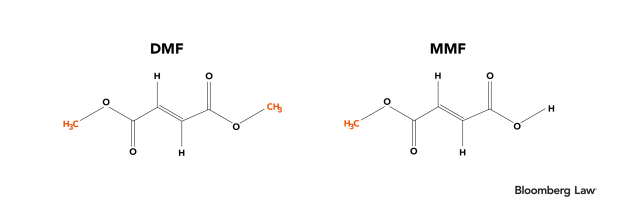INSIGHT : La décision de Biogen montre la nécessité d'une collaboration clinique et juridique

Dans affaire Biogen International GmbH c. Banner Life Sciences LLC, un panel de la Cour d'appel des États-Unis pour le circuit fédéral (CAFC) a estimé que la portée d'une restauration de la durée d'un brevet en vertu de l'article 35 U.S.C. §156 ne comprend que le principe actif d'un produit approuvé (dans ce cas, le diméthylfumarate ou DMF, le principe actif du Tecfidera® de Biogen) ou un ester ou un sel de ce principe actif.
En confirmant le jugement rendu par le tribunal de première instance, la CAFC a convenu que le composé utilisé dans le produit incriminé de Banner (le fumarate de méthyle, également connu sous le nom de fumarate de monométhyle ou MMF) n'est ni le principe actif ni un ester ou un sel de ce principe actif.
Ainsi, la CAFC n'a constaté aucune violation par Banner de la partie du terme du brevet en litige, qui a été prolongé en raison de « retards » liés au processus d'obtention de l'autorisation réglementaire de commercialisation du Tecfidera® de Biogen.
Nous aimerions exercer notre liberté littéraire et remonter le temps afin de réviser l'histoire et proposer un scénario hypothétique « inversé » dans lequel Biogen, ou tout autre innovateur pharmaceutique dans une situation similaire, ferait un choix différent dès le début de son programme de développement de médicaments, modifiant ainsi le résultat dans cette affaire et permettant à Biogen de remporter la victoire.
En décrivant le scénario hypothétique inverse, nous espérons attirer l'attention, même avec le recul, sur les avantages d'une collaboration étroite entre les conseillers cliniques et juridiques d'un innovateur pour décider, parmi deux ou plusieurs choix, quel composé désigner comme principal candidat médicament de la société.
La revendication 1, seule revendication indépendante du brevet litigieux, US 7 619 001 B2, est reproduite ci-dessous :
- Procédé de traitement de la sclérose en plaques comprenant l'administration, à un patient nécessitant un traitement pour la sclérose en plaques, d'une quantité d'une préparation pharmaceutique efficace pour traiter la sclérose en plaques, la préparation pharmaceutique comprenant au moins un excipient ou au moins un support ou au moins une combinaison de ceux-ci ; et du fumarate de diméthyle (DMF), du fumarate de méthyle (MMF), ou une combinaison de ceux-ci. (abréviations ajoutées)
De plus, les structures chimiques du DMF et du MMF sont représentées ci-dessous :

Au risque de dévoiler la conclusion de cet article, nous notons que même un examen superficiel de leurs structures chimiques révèle que le DMF est un ester méthylique du MMF.
Le brevet litigieux devait initialement expirer le 1er avril 2018. Sa durée a été prolongée de 811 jours en vertu des dispositions de l'article 156, et la partie prolongée de la durée doit expirer le 20 juin. Se référant à l'article 156, la CAFC a écrit :
- Le paragraphe (b) limite la portée de la prolongation du brevet à « toute utilisation approuvée pour le produit » et, en outre, pour les brevets relatifs à des méthodes de traitement, aux utilisations également « revendiquées par le brevet ». § 156(b)(2). Il est essentiel, aux fins du présent appel, que le paragraphe (f) définisse le « produit » comme « le principe actif d'un nouveau médicament, y compris tout sel ou ester du principe actif ». § 156(f)(2)(A).
De plus, la CAFC a ajouté que :
- Le terme « ingrédient actif » est un terme technique défini par la FDA comme « tout composant destiné à fournir une activité pharmacologique ou un autre effet direct », 21 C.F.R. §210.3(b)(7), et il « doit être présent dans le médicament lorsqu'il est administré ». (citation omise)
Le DMF faisait l'objet d'un développement expérimental (IND 73061) aux États-Unis pour le traitement de la sclérose en plaques depuis 2006. Au moment où Biogen a soumis sa demande d'autorisation de mise sur le marché (NDA) à la FDA en février 2012, qui a été approuvée par la FDA en mars 2013, le brevet en cause et l'objet de ses revendications avaient été accordés bien avant (novembre 2009).
Comme mentionné ci-dessus, les demandes portaient sur le DMF, le MMF ou une combinaison des deux. Nous ne pouvons que spéculer sur les raisons (par exemple, meilleur profil de sécurité, meilleure disponibilité orale, stabilité, facilité de fabrication) qui ont poussé Biogen à poursuivre le processus d'autorisation en faveur du DMF (plutôt que du MMF, seul métabolite actif du DMF).
Il est toutefois évident que le MMF était également disponible, puisqu'il était présent dans une combinaison d'esters de fumarate contenue dans le Fumaderm®, un médicament approuvé en Allemagne en 1994 pour le traitement du psoriasis. Dans le cadre de ce scénario hypothétique inversé, nous supposons que le MMF n'avait pas non plus été préalablement approuvé par la FDA et aurait été classé comme une nouvelle entité chimique (NCE). Si notre hypothèse est correcte, et toutes choses étant égales par ailleurs, Biogen aurait pu choisir de poursuivre avec le MMF comme candidat principal.
Si Biogen avait choisi le MMF comme principal candidat et avait finalement obtenu l'autorisation de commercialisation du MMF par la FDA, Biogen aurait tout de même pu choisir le brevet en litige pour la restauration de la durée du brevet en vertu de l'article 156, car le brevet en litige couvre l'utilisation approuvée du DMF, du MMF ou d'une combinaison des deux.
Si Biogen avait choisi le MMF comme principe actif du Tecfidera®, elle aurait bénéficié de la prolongation de la durée du brevet litigieux sans concurrence générique, car cette prolongation aurait couvert l'utilisation du MMF comme principe actif, « y compris tout sel ou ester du principe actif » en vertu de l'article 156(f)(2)(A). Pfizer Inc. c. Dr. Reddy’s Labs. Ltd., 359 F.3d 1361 (Fed. Cir. 2004).
En conséquence, dans le scénario hypothétique inverse, si Banner avait présenté le DMF comme l'ingrédient actif du produit incriminé, Biogen aurait obtenu gain de cause, car le DMF est un ester de l'ingrédient actif, le MMF. En effet, Banner aurait pu choisir n'importe quel ester du MMF et Biogen aurait quand même gagné.
Si Biogen avait choisi le MMF comme candidat principal, l'affaire Biogen c. Banner n'aurait jamais eu lieu.

